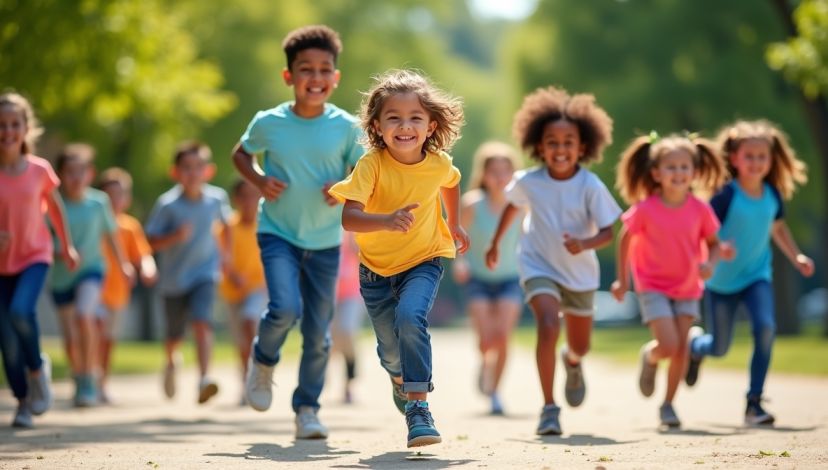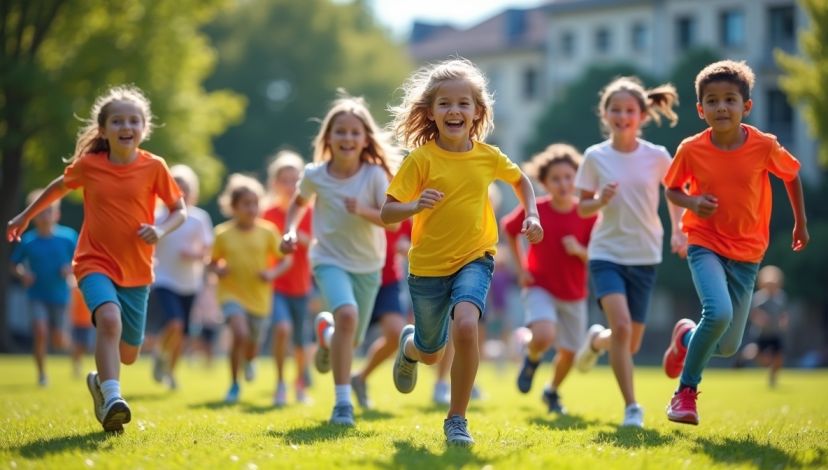Why Is There A Growing Concern Over The Physical Fitness Of Children And Adolescents?

Over the last few years, the issue of physical fitness of children and adolescents received more than enough attention. This is because of the impending downward sliding trend in physical activity and fitness of youths and their future health hazards. This has been an alarming trend because of modern lifestyles, greater amounts of screen time, unhealthy eating, and less physical education. The aftermath is both broad and specific, as it concerns not simply physical well-being, but the mental, and academic success. This raises the question: why is there a growing concern over the physical fitness of children and adolescents? It is important to gain insights into this issue so as to solve the problem and hopefully create healthier lifestyles in children and adolescents.
Table of Contents
- Why Is There A Growing Concern Over The Physical Fitness Of Children And Adolescents When It Comes To The Impacts Of Sedentary Behavior?
- Why Is There A Growing Concern Over The Physical Fitness Of Children And Adolescents Due To The Role Of Poor Nutrition?
- Why Is There A Growing Concern Over The Physical Fitness Of Children And Adolescents Regarding The Role Schools And Communities Play?
- What Are The Long Term Health Consequences To Unfit Children?
- What Role Can Parents And Caregivers Play to Enhance Physical Fitness?
- Conclusion
- FAQ’s
Key Points:
- Unhealthy lifestyle and sitting hours are key causes of poor physical fitness.
- Childhood obesity and health problems are on the rise related to poor nutrition and lack of activity.
- The schools and communities experience difficulties in delivering the available physical activity opportunities.
Why Is There A Growing Concern Over The Physical Fitness Of Children And Adolescents When It Comes To The Impacts Of Sedentary Behavior?
A sharp rise in inactive lifestyles is among the core reasons as to why the physical fitness of children and adolescents has become one of the major causes of concerns. Modern children spend much of their time seated, both in class and when completing their assignments, or using other electronic gadgets such as smartphones, tablets and video games. Research indicates that 8-18-year-old children averagely spend 7.5 hours on the entertainment media, which gravely lessens the time to get physical exercises.
Such a sedentary life has the side effects of poor posture, weak muscles and low cardiovascular endurance. As an illustration, the child who mostly spends free time indoors playing video games or browsing through social networks is less likely to build up muscle strength and stamina required in the process of healthy development. This non-existence of movement also impairs the health of the bone putting them at risk of bone damage and other pathologies that come when one gets old. The most important thing is to motivate children to pay less time in front of screens, to engage in sports, bike, be able even to play actively and to revert these trends.
Why Is There A Growing Concern Over The Physical Fitness Of Children And Adolescents Due To The Role Of Poor Nutrition?
Physical fitness does not exist only in exercise; food also plays a very important role. Poor eating habits also contribute to the rising health concerns about the physical fitness of children and adolescents.Most children eat processed food, sweetened beverages, and fast foods that contain a high amount of calories with a low level of necessary nutrients. As kids consume more energy intake compared to the expenditure of the energy by the body through unhealthy foods, it results in weight gain and obesity.
Children who lead active lifestyles may still experience diet-related health issues if they consume unhealthy nutrition. As an example, a child who consumes high amounts of sugary foods without sufficient vitamins and minerals will become tired, will not develop his/her muscles well, and will have a low immunity.This combination creates a negative cycle that lowers physical fitness and increases the risk of developing chronic conditions like type 2 diabetes and high blood pressure.
Why Is There A Growing Concern Over The Physical Fitness Of Children And Adolescents Regarding The Role Schools And Communities Play?
The role of schools and communities in development of physical fitness in children is crucial but most schools are finding it hard to meet the rising demand of physical activities. Cuts in the budget and academic demands have resulted to the reduction of physical education (PE) activities in schools with some having to eliminate the everyday PE lessons. Some areas have cut or eliminated recess time, which reduces the amount of unstructured playtime children have.
Also, a high number of poor areas do not have accessible safe parks, sidewalks, or recreational areas, and this limits children to move freely outside school. When children have no stores to safe and supporting environment, they are not likely to benefit in regular physical activity. It is one of the reasons as to why the focus towards the physical fitness of children and Adolescents is becoming a concern today because it becomes more difficult to inculcate healthy habit at an early age.
Comparison Table: Opportunities of Physical Activity in Schools vs. Communities
| Aspect | Schools | Communities |
|---|---|---|
| Physical Education | Often reduced or eliminated | Limited safe recreational spaces |
| Structured Activities | PE classes, sports teams | Community sports, parks |
| Unstructured Play | Recess or free play time | Outdoor play areas |
| Barriers | Budget cuts, academic focus | Safety concerns, lack of facilities |
What Are The Long Term Health Consequences To Unfit Children?
The impact of poor fitness is serious long term health concerns, and this is what justifies the increasing anxiety about the physical fitness of children and adolescents. Cases of diseases that were believed to occur in adults are now being manifested in children and adolescents by their doctors. These are hypertension, high -cholesterol, insulin resistance, chronic fatigue and joint pain.
This generation will be living shorter lives than their parents as compared to modern history in case these trends persist. Lack of physical activity and poor diet leads to childhood obesity that predisposes a person to heart disease, stroke, and type 2 diabetes in the future5. An early intervention is important to avoid these outcomes. Healthy eating habits and physical workouts should be encouraged at an early age to minimize such risks because it will also support overall well-being in adulthood.
Table of Comparisons: Risks to Health when children are Physically Fit and when they are Unfit
| Health Aspect | Physically Fit Children | Physically Unfit Children |
|---|---|---|
| Cardiovascular Health | Lower risk of heart disease | Higher risk of heart disease |
| Weight Management | Healthy body weight | Higher risk of obesity |
| Bone and Muscle Strength | Strong bones and muscles | Weak bones, muscle loss |
| Mental Health | Better mood and lower anxiety | Higher risk of depression |
| Academic Performance | Improved concentration and learning | Decline in academic performance |
What Role Can Parents And Caregivers Play to Enhance Physical Fitness?
Parents and caregivers play an imperative task in curbing the rising issue of physical fitness among children and adolescents. They are able to get our children to adopt healthy activities including reducing their time on screens and encouraging outdoor activities and sports. Modeling by their active behavior assists the child to set the same trends.
It is also important to give healthy meals and snacks. The aim of sustaining balanced diets consisting of fruits, vegetables, whole grains, and lean proteins with restricted sugary and processed foodstuffs should be adopted by families. It is necessary to build the environment that encourages children to be active and does not cause them to feel threatened.
Families can be assisted by providing convenient programs and safe physical activities provided by the schools and communities. Co-operation among parents, teachers, and local government should be aimed at creating better and healthier conditions that facilitate children to grow physically and mentally.
Note: It is possible to make children physically fit over the time through encouraging minor updates in their daily life routine that would have no substantial impact at first but eventually will contribute to major results.
Note: The positive effects of physical fitness occur not only in the realm of physical health, but also increase the level of mental well being and academic achievement.
Conclusion
The increasing awareness about the physical fitness of children and adolescents is a multifactorial problem to a sedentary lifestyle, lack of nutritional choices, less physical education, and a lack of safe playing grounds. These are some of the factors that cause increased levels of obesity, chronic diseases and mental health issues among the youth. The only solution to this concern is to make a concerted effort at transactional levels of families, schools, communities, and policymakers to propagate decent exercises and good diets. Early intervention and regular monitoring may help to make sure that children and adolescents acquire physical fitness, which will result in healthy and satisfying life.
FAQ’s
Which are the major factors that contribute to physical deconditioning among children and adolescents?
The main reasons include more time on screens, unhealthy food and the decreased physical education.
What are the long-term consequences of poor physical fitness to children?
It provides more risks to suffer chronic illnesses such as diabetes, heart, and obesity.
Why are schools significant in enhancing physical fitness?
Schools encourage structured physical activity and education which leads to formation of lifelong habits.
What is the importance of nutrition in physical fitness of children?
Adequate nutrition gives energy to physical activities and helps in proper growth and development in the body.
What can be done to specifically motivate better-physical-fitness in children?
By curtailing time on the screen, encouraging active play and offering nutritious food options.
Latest Posts

Chipotle Nutrition – Your go-to guide for calories, healthy choices, and balanced meals at Chipotle.
TOP NEWS
© Copyright 2025 Chipotle Nutrition. All rights reserved












No Comments